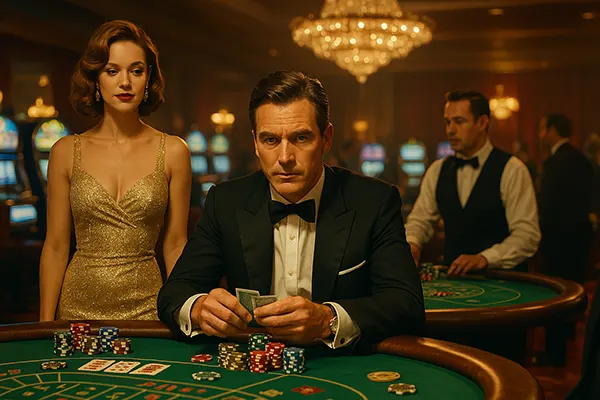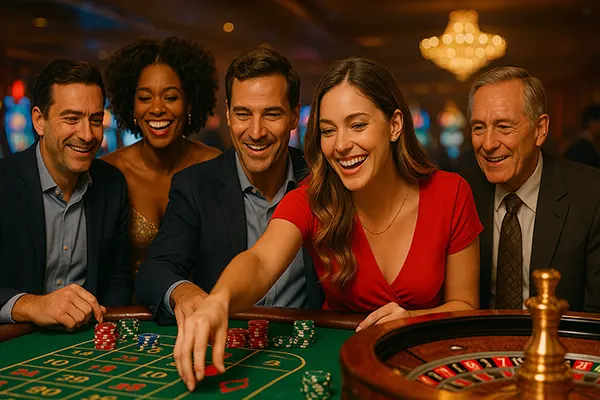
The Golden Age of Casinos in Film: How Hollywood Shapes Our Perception
The cinematic portrayal of casinos has long captured the imagination of audiences worldwide. From glamorous heists to high-stakes games, Hollywood has played a critical role in shaping how viewers perceive the world of gambling. But how close are these representations to reality, and what influence do they exert on players and public perception in 2025?
The Glamour and Allure of Casino Films
Casino-themed films are often synonymous with extravagance, risk, and seduction. Classic titles like “Casino” (1995), “Ocean’s Eleven” (2001), and “The Hangover” (2009) glorify the opulence and adrenaline associated with gambling. These movies contribute to an idealised image of casinos as luxurious playgrounds for the elite, where fortune can change with a single card flip.
This portrayal is intentional: Hollywood uses casinos as visually and emotionally charged settings to develop characters and tension. Lavish interiors, expensive suits, and dramatic wins create a fantasy that captivates the audience. While entertaining, these depictions tend to sideline the everyday experiences of real-life players, many of whom engage in online platforms rather than grandiose land-based venues.
In 2025, this influence remains potent. Casino operators, especially in the digital space, often incorporate cinematic elements into branding and gameplay—evoking the thrill and glamour seen on screen to appeal to new audiences.
How Films Set Expectations for Real-World Gambling
The expectations set by Hollywood frequently contrast with the reality of contemporary gambling. Most modern players participate through regulated online casinos, where the experience is more practical than theatrical. Yet, the legacy of cinematic storytelling can shape how players approach games—expecting drama, rapid wins, or high social status associated with gambling.
Film tropes also influence beliefs about luck, skill, and probability. Characters portrayed as charismatic risk-takers often succeed by relying on instinct or clever tricks, rather than strategic play or understanding odds. This contributes to common myths about gambling that persist even in an age of data-driven responsible gaming tools.
Many players, especially younger ones, approach casinos influenced by the polished, story-driven visuals they’ve consumed for years. As a result, real-world gambling platforms must increasingly work to manage expectations and promote transparency and safe play through education and design.
Historical Evolution of Casino Representation in Cinema
Casino representation has undergone significant transformation since the mid-20th century. In the early years, films like “The Cincinnati Kid” (1965) portrayed the casino environment as gritty and competitive, reflecting post-war realities. During the 1990s and early 2000s, the trend shifted towards stylised depictions with slick editing, sharp wardrobes, and a focus on criminal underworlds intertwined with gambling operations.
Modern portrayals have begun to blend fantasy with realism. For instance, in “Casino Royale” (2006), James Bond’s poker game is both glamorous and tense, yet more grounded in rules and psychology. Such films balance authenticity with narrative flair, reflecting the maturing tastes of viewers more familiar with gambling mechanics.
In 2025, we see a rise in streaming series and films incorporating online gambling narratives, reflecting the industry’s shift toward digital-first experiences. These stories now explore themes such as data protection, addiction awareness, and tech-driven regulation, aligning more closely with the current casino landscape.
How Casino Tropes Have Shifted Over Time
Earlier films relied heavily on fixed tropes: the suave gambler, the scheming mob boss, and the naïve newcomer. These roles offered familiar story arcs that supported moralistic endings—win big or lose everything. Over time, these have evolved into more nuanced characters reflecting modern complexities, including addiction, ethical dilemmas, and the role of technology.
Streaming platforms in 2025 now favour character-driven narratives over stylised montages. This change speaks to a broader trend in consumer media—realism over spectacle. Although the glamour remains, there is increasing emphasis on the consequences of high-risk behaviours and the psychology behind gambling addiction.
This shift influences both public attitudes and policymaking, as audiences are exposed to more balanced portrayals. Today’s filmmakers are more likely to collaborate with consultants and psychologists to ensure accurate representations that don’t glorify harmful habits.

Hollywood’s Impact on Casino Industry Branding
The visual identity of many casinos—both physical and digital—is heavily influenced by cinematic conventions. From red carpets and velvet ropes to moody lighting and jazz-lounge soundtracks, the goal is to transport the player into a movie-like experience. Hollywood has essentially set the standard for what “luxury gambling” should look and feel like.
Online casinos in 2025 now mirror this aesthetic, using sleek UI design, story-based slots, and high-production-value live dealer games to replicate the atmosphere of famous films. These branding choices are not accidental—they are deliberate nods to audience familiarity and comfort with Hollywood tropes.
By aligning branding with cinematic storytelling, gambling operators can offer an emotionally engaging experience. This also provides a competitive edge in a crowded marketplace, especially among platforms that prioritise immersive entertainment alongside gameplay.
The Future of Casino Imagery in Media
Looking ahead, the intersection of virtual reality, artificial intelligence, and media production is poised to further reshape the portrayal of casinos. In 2025, some platforms are already testing VR lobbies that simulate the look and feel of movie-style casinos, offering players a 360-degree environment inspired by their favourite films.
As AI tools become more integrated into both gaming and content creation, we may see personalised film-inspired casino experiences tailored to user preferences. Players could enter a digital venue styled like a 1920s speakeasy or a cyberpunk metropolis—all depending on their viewing habits and game history.
Hollywood’s ongoing collaboration with tech firms and game developers means that the cinematic influence on gambling is not only enduring—it’s evolving. For players, this could lead to deeper immersion, while regulators will face fresh challenges in ensuring that entertainment does not overshadow safety.
